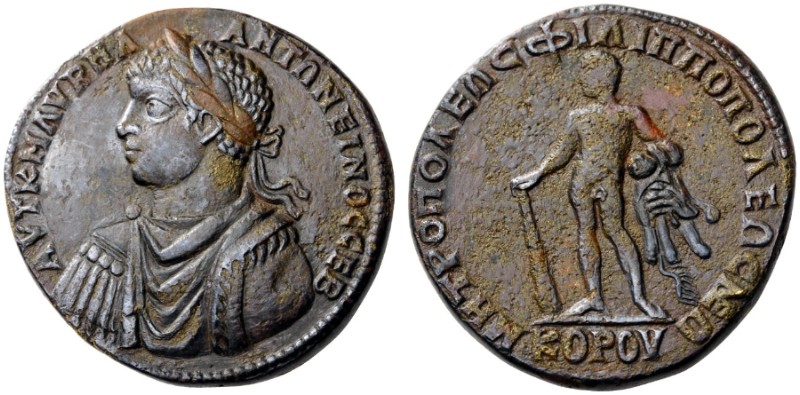Lot 115

Philippopolis, Thrace. Elagabalus, 218-222. Okatassarion or ‘Quinarius’ (Bronze, with contempoary silver plating, 40mm, 38.77 g 12). ΑΥΤ Κ Μ ΑΥΡΗΛ ΑΝΤΩΝΕΙΝΟC CΕΒ Laureate, draped and cuirassed three-quarter length bust of Elagabalus to left. Rev. ΜΗΤΡΟΠΟΛΕΩC ΦΙΛΙΠΠΟΠΟΛΕΩC ΝΕΩ / ΚΟΡΟΥ Youthful Herakles standing left, nude but for lionskin draped around his left forearm, resting his right hand on the handle of a club set on the ground and holding an apple in his left. SNG Copenhagen 784 (same dies). An extraordinary piece, especially with remains of its original silver plating. Some marks from cleaning, otherwise, about extremely fine.
During the Empire many Greek cities in the eastern Mediterranean area produced very large sized bronze coins. Commonly termed ‘medallions’ in numismatic literature, they should, in fact, be seen as commemorative high denomination circulating coins. The concept of a monetiform medal only began in the Remaissance, when artists, using Roman sestertii and other large-sized ancient coins as their models, began making them. As can clearly be seen from Roman precious metal ‘medallions’, the ancient versions, like the over-sized Imperial bronzes that were minted in Rome and were particularly common during the 2nd century, all had some sort of understood monetary value. Gold and silver pieces were actually multiples of normal denominations - this must have been the case for aes as well (you could have bimetallic pieces that would have been double sestertii or more). We can be certain of this because while some bronze were clearly kept as keepsakes, others must have circulated since they turn up in hoards containing all manner of smaller coins. This is even clearer with the many large-sized AE issued by the Greek cities in the eastern provinces of the Roman Empire. Since only a very few mints were allowed to strike silver coins, and those only for regional use such as the cistophori of Asia Minor or the various types from Caesarea in Cappadocia, the proud cities of Asia had to turn to the issuance of exceptionally large and heavy bronze coins when they wanted to celebrate a special event. These coins would have been the equivalent of quinarii and denarii, among others, and would have been easily recognized by their exceptional size (far bigger than contemporary sestertii for example). The fact that this piece was given a silver plating when it was made emphasizes its special nature and high denomination.
Current Status
Online bidding closes: 18 May 2015, 11:00:00 CEST Current Date & Time: 20 Apr 2024, 02:53:01 CEST Remaining Time: Closed Hammer Price:3600 CHFPre-Bidding closes on 18 Mai 2015 at 11:00 CEST. Live bidding starts at 14:00 CET and is EXCLUSIVELY available on biddr. Separate registration is required.
